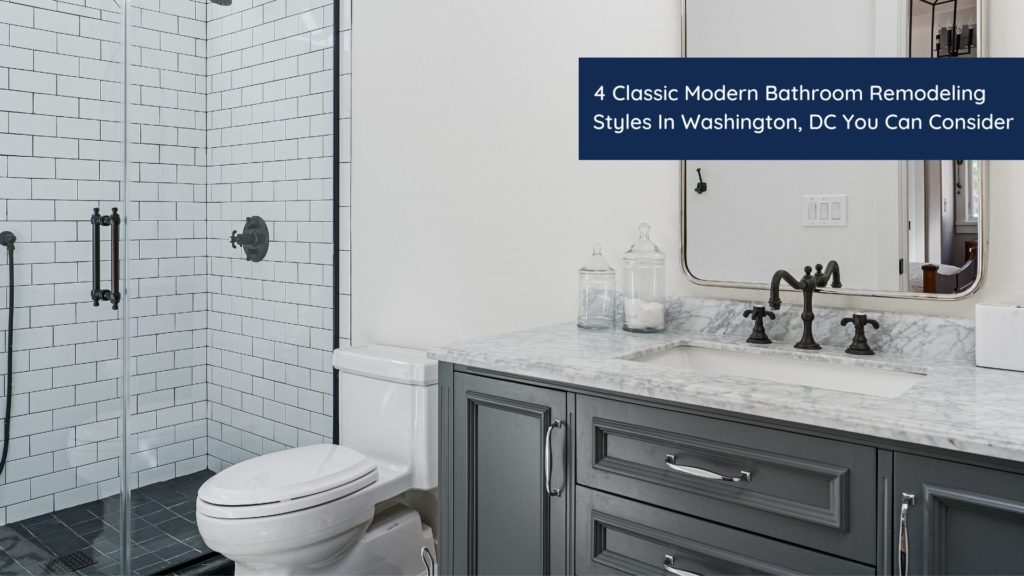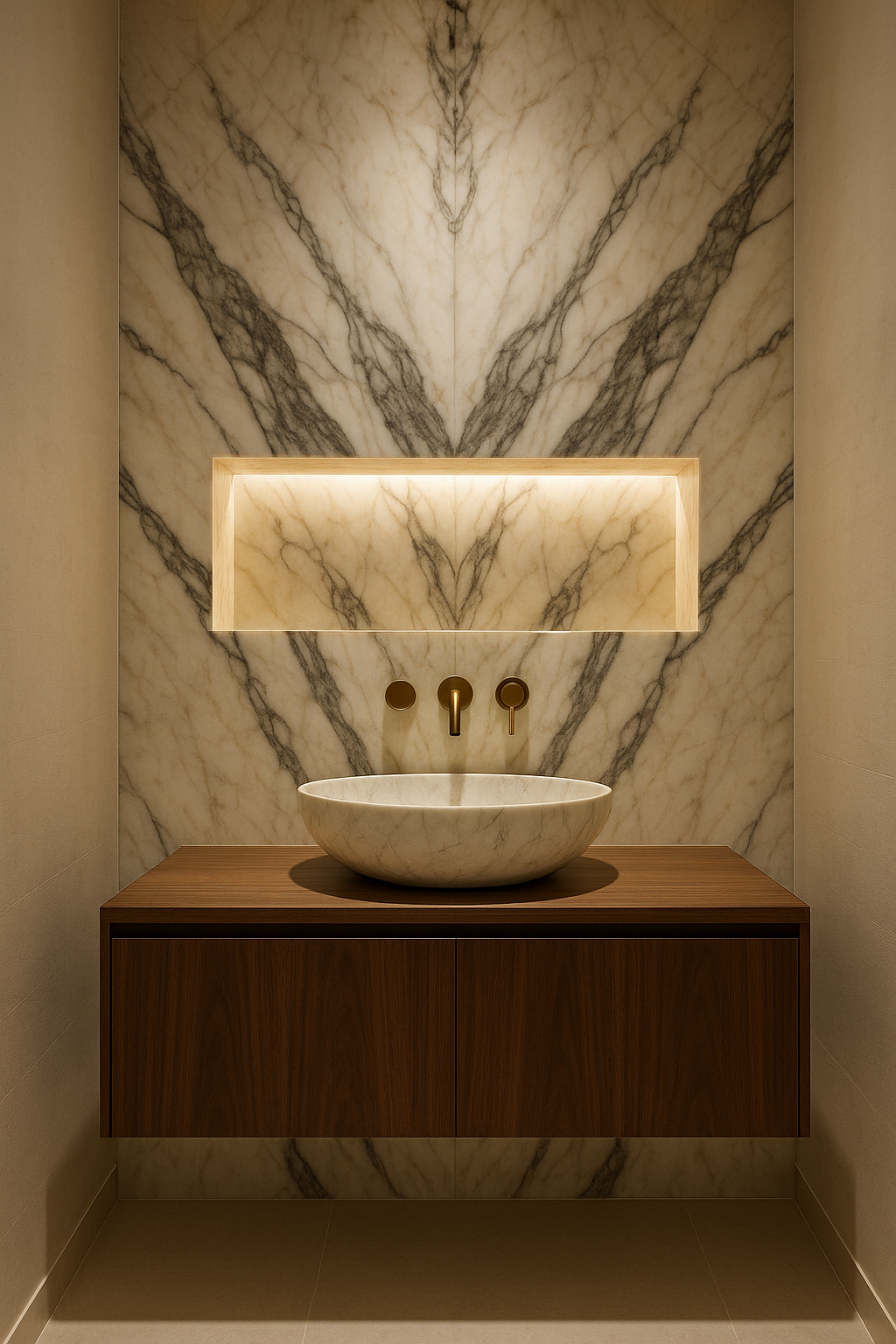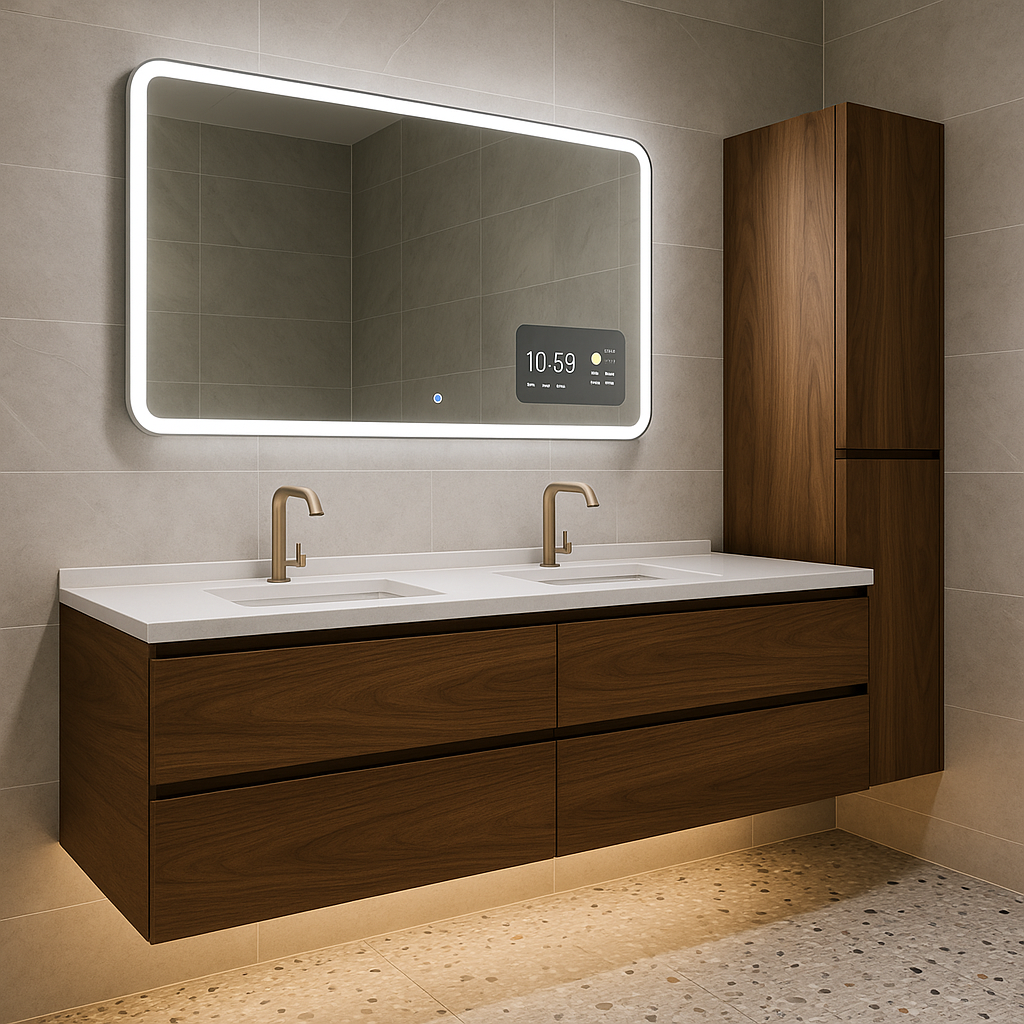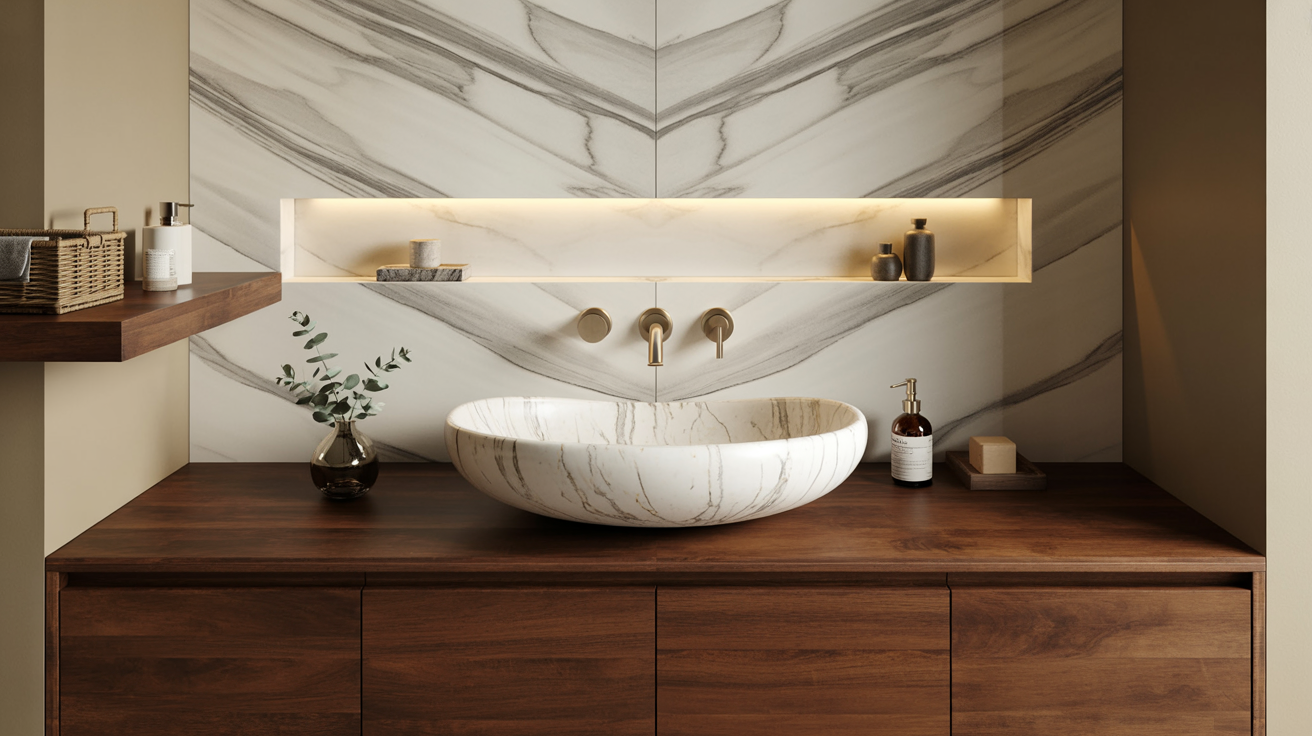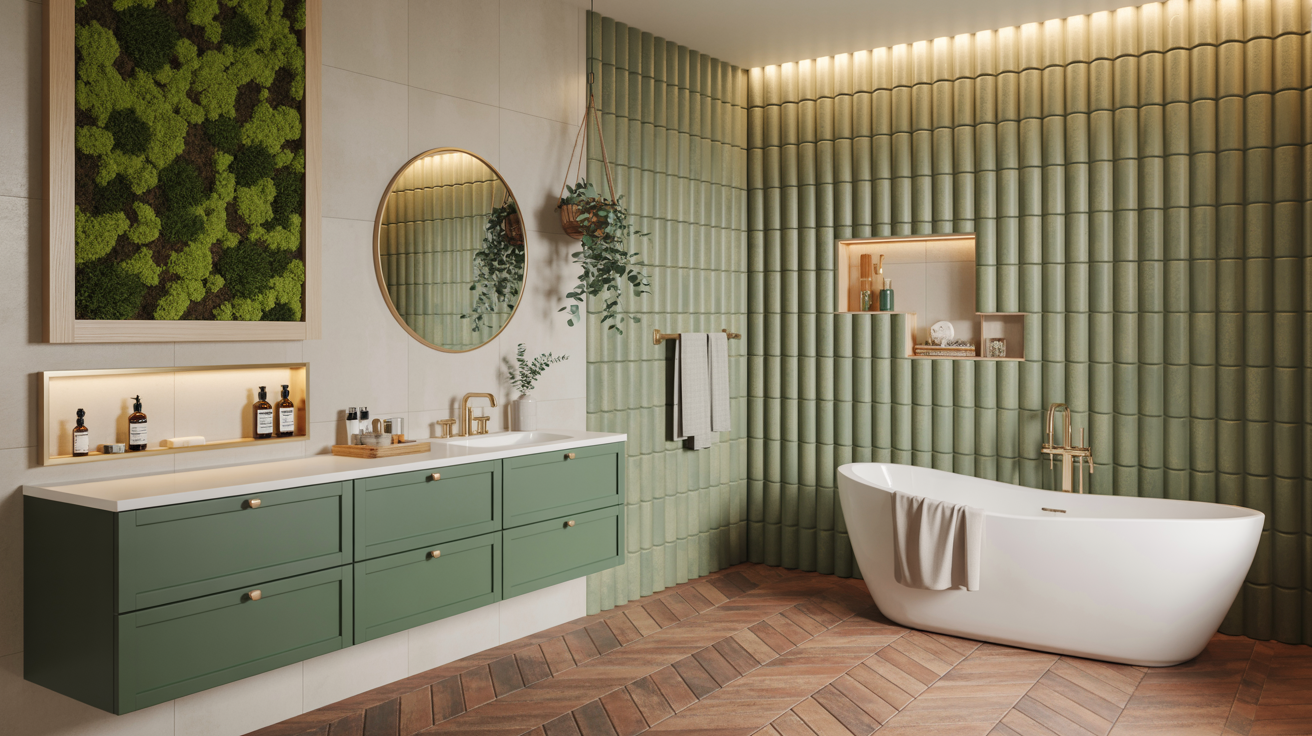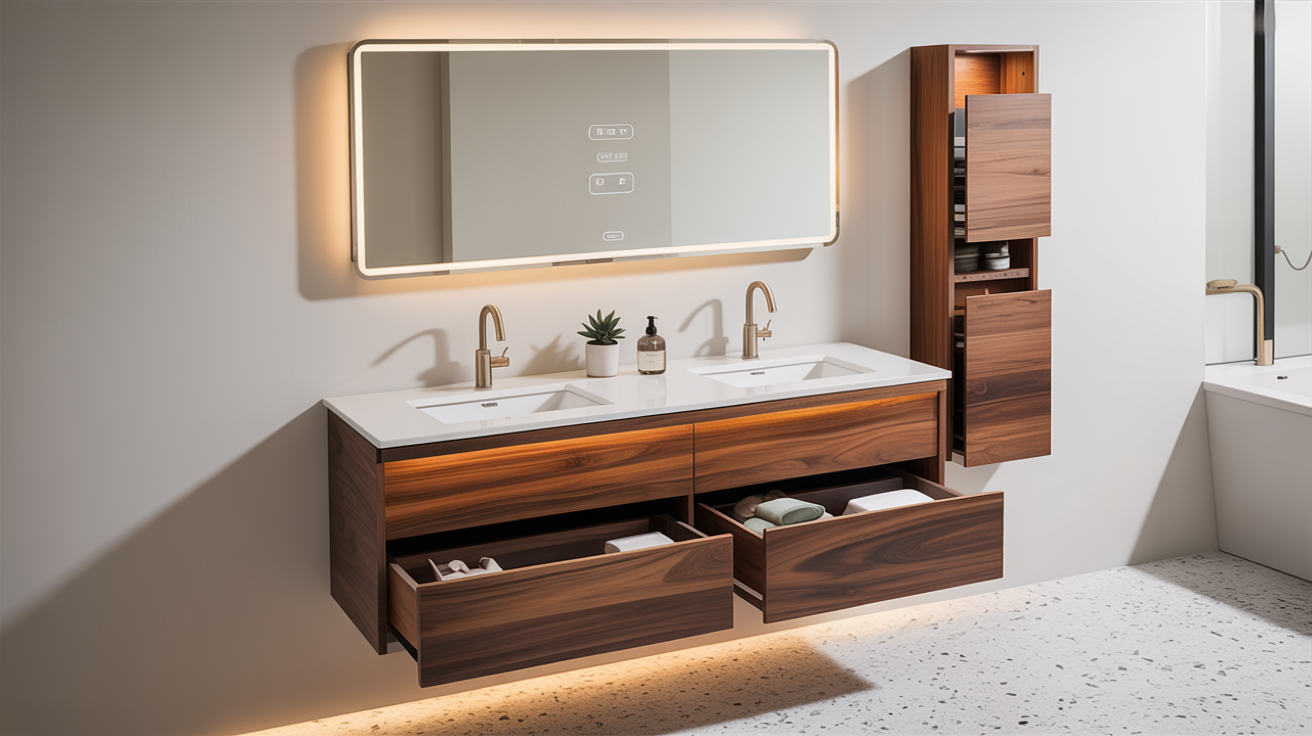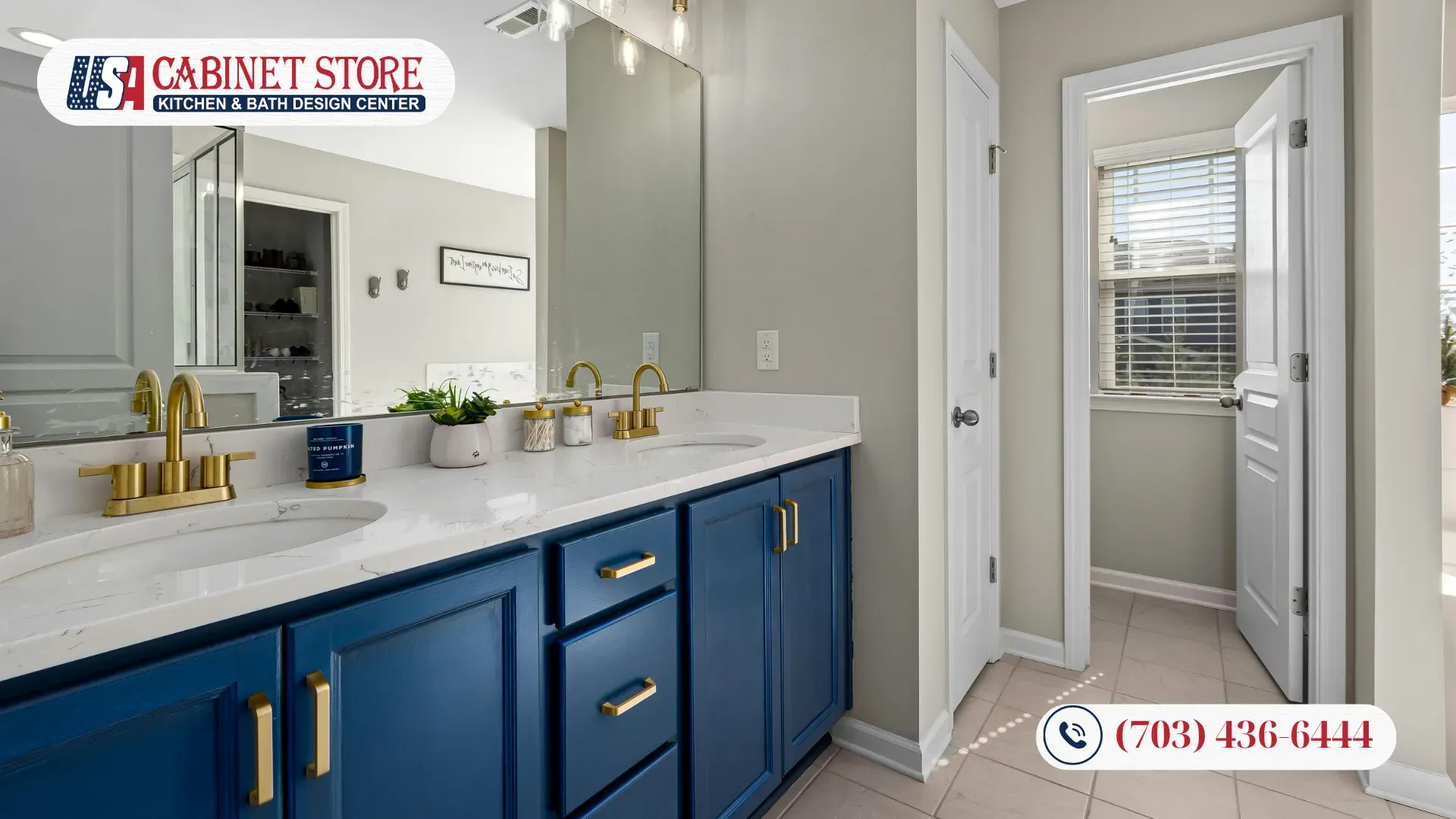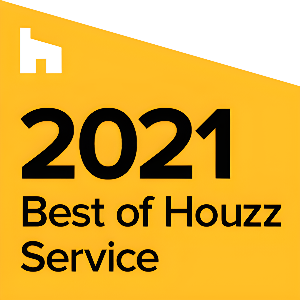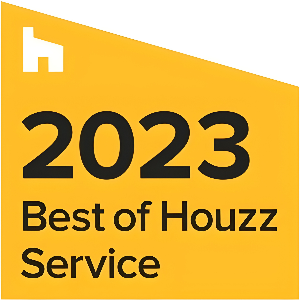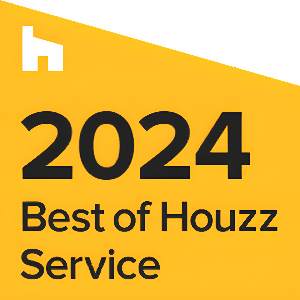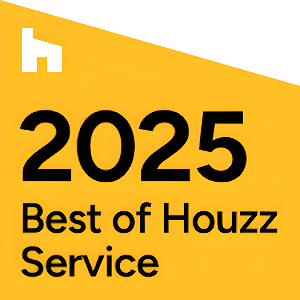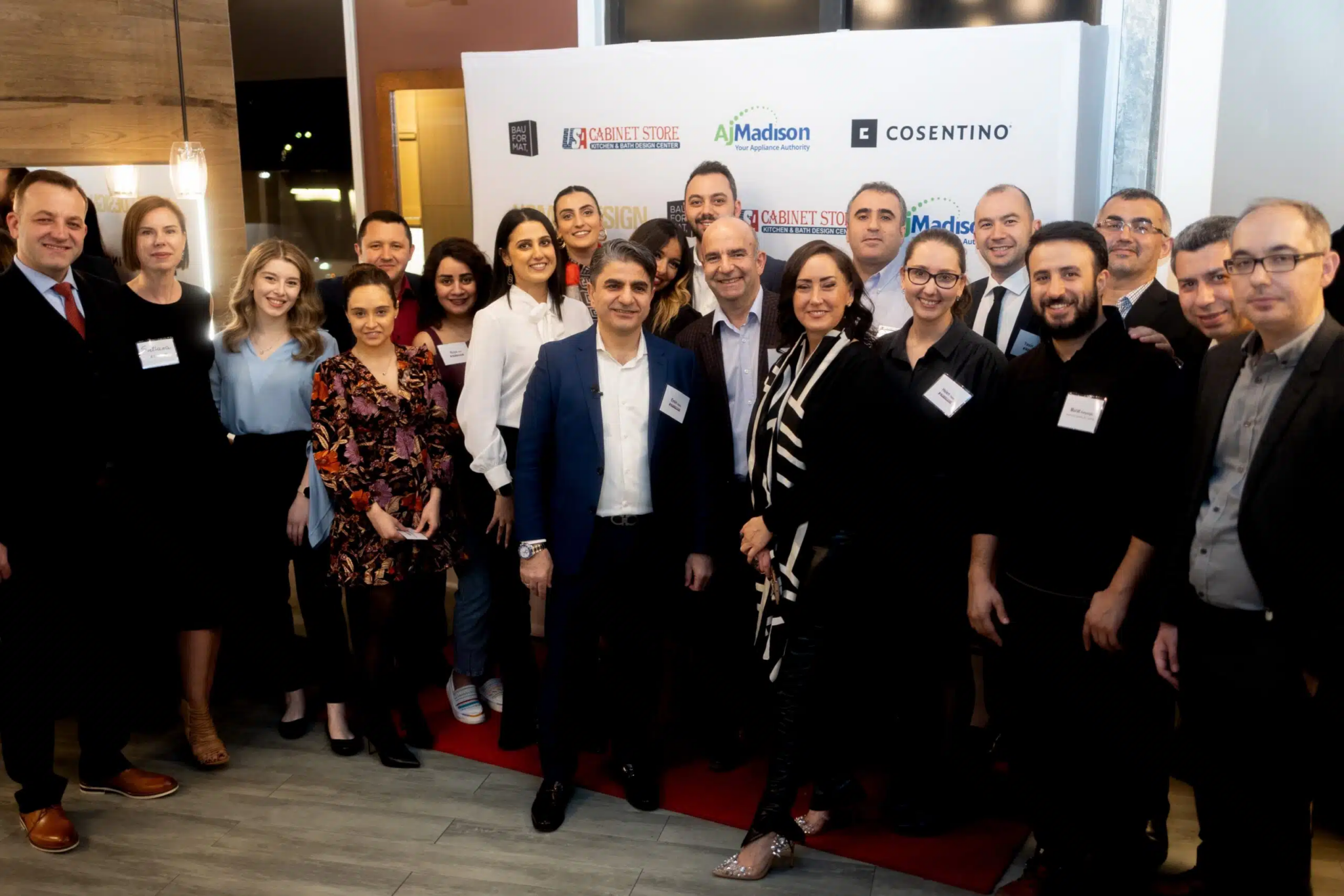Updated October 2025 – Originally Published 2022
Are you dreaming of a sophisticated bathroom renovation that captures Washington DC’s distinctive blend of historic charm and contemporary luxury? Your timing couldn’t be better. Since we originally published this guide in 2022, the classic modern bathroom has undergone a remarkable transformation, evolving from a niche design concept into the most coveted bathroom style for 2025-2026.
What’s Changed Since 2022: The bathroom design landscape has shifted dramatically. Chrome fixtures have been replaced by brushed brass and matte black finishes. Painted white cabinets have given way to warm wood tones in sealed oak and walnut. Traditional vanities have been displaced by floating wall-mounted designs that create visual spaciousness. Basic functionality has evolved into smart technology integration with touchless faucets, programmable showers, and intelligent mirrors. The focus has shifted from purely aesthetic updates to wellness-centered sanctuaries featuring biophilic design, natural materials, and spa-like experiences.
What’s Hot in 2026: Sculptural freestanding bathtubs with asymmetrical profiles now serve as room centerpieces. Microcement has emerged as the material of choice for seamless, organic surfaces. Three-dimensional fluted and ribbed tiles add tactile texture. Earth tones including sage green, terracotta, and forest hues have replaced stark whites. Sustainability and water conservation have become non-negotiable priorities rather than optional upgrades.
This harmonious fusion of timeless elegance with cutting-edge innovation resonates particularly well in the nation’s capital, where Federal-style architecture meets modern urban living. Whether you’re transforming a Georgetown row home, updating a Capitol Hill residence, or renovating an Alexandria Colonial, classic modern design offers the versatility to honor your home’s heritage while embracing today’s lifestyle demands.
10 Key Takeaways for Your Classic Modern Bathroom
Space & Flow: Floating vanities create the illusion of more space while providing accessible storage underneath
Natural Materials: Warm wood tones in moisture-resistant finishes like sealed white oak and teak are dominating vanity selections
Smart Integration: Touchless faucets, programmable showers, and smart mirrors with Bluetooth capabilities enhance daily routines
Texture Focus: Fluted and ribbed cabinet fronts add tactile interest while maintaining clean, modern lines
Color Evolution: Rich earth tones including sage green, warm terracotta, and deep forest hues replace stark whites
Sculptural Elements: Freestanding bathtubs and vessel sinks serve as artistic focal points rather than mere fixtures
Sustainability Priority: Water-saving fixtures and eco-friendly materials align with DC’s environmental consciousness
Lighting Innovation: Layered lighting schemes with LED integration and smart controls create spa-like ambiance
Storage Solutions: Vertical tower storage and hidden compartments maximize functionality in compact DC spaces
Wellness Design: Biophilic elements and natural textures promote relaxation and mental well-being
Table of Contents
The Classic Modern Bathroom Redefined for 2026
The essence of a classic modern bathroom lies in its sophisticated balance between enduring design principles and forward-thinking innovation. This approach has evolved significantly since our original article in 2022, now incorporating biophilic design elements, advanced smart technology, and sustainable materials that reflect our growing awareness of wellness and environmental responsibility.
In Washington DC’s unique architectural landscape, classic modern design bridges the gap between the city’s Federal and Colonial heritage and contemporary urban sophistication. The style draws inspiration from multiple eras while creating something entirely fresh and relevant for today’s homeowners. Rather than mimicking period details, it interprets classical proportions and materials through a modern lens, resulting in spaces that feel both familiar and revolutionary.
What sets 2026’s classic modern bathrooms apart is their emphasis on sensory experience and emotional wellness. These spaces prioritize natural light, organic materials, and intuitive functionality, creating sanctuaries that support both daily routines and restorative rituals.
Classic Elements Evolved
The foundational elements of classic design have been reimagined for contemporary living while maintaining their essential character and appeal.
Architectural Details remain paramount, but with refined execution. Crown molding and wainscoting now feature cleaner profiles and integrated LED lighting, while column-inspired elements appear as floating supports for modern fixtures rather than structural columns. These details create visual hierarchy and sophisticated proportions without overwhelming smaller DC spaces.
Natural Stone continues to anchor classic modern design, though 2026 applications favor large-format slabs and book-matched patterns that create seamless, sculptural surfaces. Marble, quartzite, and travertine are being shaped into continuous planes that flow from countertops to shower walls, creating an enveloping sense of luxury.
Freestanding Bathtubs have evolved beyond traditional clawfoot designs to embrace asymmetrical profiles and organic curves that function as sculptural centerpieces. These statement pieces anchor the room’s design while providing the spa-like experience that defines luxury bathrooms in 2026.
Modern Bathroom Innovations for 2026
Today’s classic modern bathrooms seamlessly integrate technology and sustainability without compromising their timeless appeal.
Smart Technology appears through touchless faucets with temperature presets, programmable shower systems, and smart mirrors with anti-fog capabilities. These innovations enhance daily routines while maintaining the clean aesthetic that defines the style. Voice-activated controls and smartphone integration allow for personalized comfort settings that adapt to individual preferences.
Sustainable Design reflects Washington DC’s environmental consciousness through water-saving fixtures, energy-efficient LED lighting, and locally-sourced materials. Low-flow toilets, greywater systems, and recycled content tiles demonstrate how luxury and responsibility can coexist beautifully.
Wellness Focus transforms bathrooms into personal sanctuaries through biophilic design elements, circadian rhythm lighting, and air purification systems. Natural materials, living walls, and aromatherapy integration create spaces that actively support physical and mental well-being.
Floating Design elements create visual lightness while maximizing floor space in compact DC homes. Wall-mounted vanities, floating shelves, and suspended storage towers provide necessary functionality while maintaining the airy, sophisticated atmosphere that defines modern luxury.
Modern Bathroom Innovations for 2026
| Style | Key Vanity Trend | Material Highlights | Smart Features | Best For Space Type | Signature 2026 Upgrade |
|---|---|---|---|---|---|
| Floating Wood Vanity | Wall-mounted, integrated | Sealed oak, walnut, quartz | Touchless faucet, LED mirror | Row homes, small bathrooms | Tower storage addition |
| Sculptural Freestanding Tub | Floor-centered focal point | Cast stone, natural wood | Digital tub filler, sound | Spacious/master baths | Asymmetrical/organic tub |
| Minimalist Vessel Sink | Petite floating design | Marble, stone slab, ceramics | Wall faucet, LED accent | Powder/guest rooms | Book-matched wall slab |
| Textured Tile Feature | 3D/fluted tiles, niches | Porcelain, microcement | Smart lighting, aroma | Master, spa suites | Wellness add-ons |
Style 1: Floating Wood Vanity with Smart Integration
This contemporary interpretation of classic modern design showcases the warmth of natural wood balanced with cutting-edge technology, creating a bathroom that feels both grounding and forward-thinking. Floating vanities have become the defining feature of 2026 bathroom design, offering practical and aesthetic benefits that make them ideal for Washington DC’s diverse housing stock.
The centerpiece features a wall-mounted vanity in moisture-resistant sealed white oak or warm walnut with a matte protective finish. These natural wood tones create immediate warmth while their floating installation opens the visual space beneath, making even compact DC bathrooms feel significantly larger. The wood grain adds organic texture that softens the hard surfaces typically found in bathrooms while providing a sophisticated contrast to sleek fixtures.
Smart integration appears through touchless faucets with programmable temperature settings, allowing users to customize their preferred water temperature through smartphone apps. The vanity incorporates hidden charging stations and integrated LED lighting that can adjust color temperature throughout the day, supporting natural circadian rhythms and enhancing the room’s wellness focus.
Storage solutions maximize functionality through soft-close drawers with interior organizers and pull-out compartments designed specifically for bathroom essentials. Tower storage positioned adjacent to the vanity provides vertical organization for towels and linens while maintaining the clean, uncluttered aesthetic. The open space beneath the floating vanity accommodates decorative baskets or robotic vacuum storage while allowing easy floor cleaning.
The countertop features a large-format quartz slab with subtle veining that complements the wood grain below. Undermount sinks maintain clean lines while wall-mounted faucets create a custom, architectural appearance that elevates the entire composition. Smart mirrors with anti-fog technology and Bluetooth connectivity complete the tech integration while maintaining the sleek, minimalist aesthetic.
This style works exceptionally well in Georgetown row homes and Capitol Hill residences where space efficiency meets sophistication requirements. The natural wood brings warmth that complements historic architecture while the smart features and floating design establish thoroughly contemporary functionality.
Style 2: Sculptural Freestanding Tub with Organic Materials
The evolution of the classic freestanding bathtub represents 2026’s most significant luxury trend, transforming these functional elements into sculptural artwork that defines the entire bathroom experience. This approach moves beyond traditional clawfoot designs to embrace asymmetrical forms and organic curves that create visual drama while enhancing bathing comfort.
Contemporary freestanding bathtubs feature deep soaking profiles with ergonomic curves designed specifically for relaxation and hydrotherapy. Materials range from cast stone composites to natural stone carved to appear weightless despite their substantial presence. These tubs function as room anchors, positioned strategically to take advantage of natural light while creating intimate conversation areas within larger bathrooms.
Complementary materials emphasize the organic, spa-like atmosphere. Microcement walls create seamless, sculptural surfaces that curve organically around shower areas and tub surrounds. This trending material offers the tactile quality of handcrafted surfaces while providing water resistance and easy maintenance. The monolithic appearance eliminates grout lines and creates flowing, continuous surfaces that enhance the room’s serene atmosphere.
Natural stone flooring in large-format tiles extends the organic theme while providing practical slip resistance around wet areas. Travertine, limestone, or honed marble creates warmth underfoot while their natural variations add visual interest without overwhelming the space’s calm aesthetic.
Floating elements maintain the room’s airy quality through suspended vanities and wall-mounted storage. Natural wood accents in moisture-resistant finishes provide warmth and textural contrast against the stone surfaces. These wooden elements might include floating shelves, towel warming racks, or integrated seating that extends the spa-like atmosphere.
Smart technology integrates subtly through digital tub fillers that can pre-program water temperature and fill levels, ambient lighting systems that adjust throughout the day, and sound systems that create immersive relaxation experiences. Floor heating and towel warming enhance comfort while air purification systems maintain optimal air quality.
This style particularly suits larger bathrooms in Northwest DC neighborhoods and suburban DMV locations where space allows for the dramatic impact of sculptural elements while maintaining circulation around the tub.
Style 3: Minimalist Vessel Sink with Natural Stone Drama
The vessel sink concept has undergone sophisticated evolution for 2026, moving beyond basic bowls to embrace sculptural forms and artisanal materials that function as bathroom jewelry. This style emphasizes the vessel sink as a design focal point while surrounding it with complementary natural materials that create visual harmony and tactile richness.
Contemporary vessel sinks feature organic shapes inspired by nature, crafted from natural stone, ceramic, or composite materials with hand-finished surfaces. White marble vessels with natural veining create elegant contrast against darker vanity surfaces, while granite or travertine options provide earthy sophistication. The key evolution involves proportion and placement, with vessels sized appropriately for their surroundings rather than overwhelming compact vanities.
Vanity design emphasizes floating installation with rich wood tones or painted finishes in trending colors like sage green, warm terracotta, or deep forest hues. The vanity width extends 12-18 inches beyond the vessel on each side, creating generous counter space and visual balance. Hidden storage within the vanity accommodates bathroom essentials while maintaining the clean, uncluttered appearance essential to the style.
Wall treatment creates dramatic backdrop through book-matched stone slabs that extend from countertop to ceiling, creating seamless vertical surfaces that make ceilings appear higher. Large-format marble, quartzite, or engineered stone with bold veining patterns provides natural artwork that complements rather than competes with the vessel sink. Integrated lighting within wall niches highlights the stone’s natural beauty while providing functional illumination.
Smart features include wall-mounted faucets with touchless activation and temperature memory settings that eliminate counter clutter while providing advanced functionality. Motion-activated LED strips beneath the floating vanity create ambient lighting that enhances the room’s sophisticated atmosphere while providing safety during nighttime use.
Storage solutions emphasize vertical organization through adjacent tower cabinets or floating shelves that maintain visual lightness while providing necessary functionality. Textural elements like woven baskets or ceramic accessories add warmth and personality without disrupting the minimalist aesthetic.
This approach works exceptionally well in guest bathrooms and powder rooms throughout the Washington DC area, where it creates memorable impressions while maximizing functionality in compact spaces. The vessel sink serves as conversation starter while the natural stone creates luxurious atmosphere appropriate for entertaining.
Style 4: Textured Tile Feature with Integrated Wellness Elements
The contemporary interpretation of patterned tilework embraces geometric precision and artisanal textures that create visual interest while supporting the room’s wellness-focused atmosphere. This style moves beyond traditional subway tile applications to incorporate three-dimensional surfaces and earth-inspired patterns that engage multiple senses while maintaining timeless appeal.
Flooring features large-format porcelain in natural stone appearances or geometric patterns that create foundation for the room’s design story. Herringbone layouts in warm earth tones provide classic elegance with contemporary scale, while hexagonal patterns in terracotta or sage green create more dynamic visual movement. The key lies in selecting patterns that complement rather than compete with wall treatments and fixtures.
Wall applications emphasize textural variety through fluted or ribbed surfaces that add tactile interest while maintaining clean, modern lines. These three-dimensional tiles create subtle shadow play throughout the day, adding visual depth without overwhelming smaller spaces. Natural clay colors in matte finishes provide sophisticated warmth that connects occupants with natural elements essential to biophilic design.
Feature walls incorporate microcement applications or large-format stone slabs that create dramatic focal points behind freestanding tubs or vanity areas. These seamless surfaces provide sophisticated backdrop for fixtures while their monolithic appearance enhances the room’s serene, spa-like atmosphere.
Integrated wellness elements include built-in aromatherapy diffusers, chromotherapy lighting systems, and sound dampening materials that create truly restorative environments. Living walls or preserved moss panels bring biophilic elements indoors while air purification systems maintain optimal indoor air quality.
Smart technology supports wellness goals through circadian rhythm lighting that adjusts color temperature throughout the day, humidity control systems that maintain optimal comfort levels, and sound systems that can provide nature sounds, meditation guides, or personalized music experiences.
Storage integration maintains clean aesthetics through hidden compartments within wall systems and floating elements that preserve visual openness. Natural wood accents provide warmth and textural contrast while brass or matte black hardware adds sophisticated finishing touches.
This comprehensive approach suits master bathrooms and spa-inspired suites where occupants seek restorative experiences that support both daily routines and long-term wellness goals. The combination of natural materials, advanced technology, and thoughtful design creates truly transformative spaces.
Essential Elements for Every Classic Modern Bathroom
Regardless of specific style direction, successful classic modern bathrooms in 2026 share fundamental characteristics that ensure both immediate impact and lasting satisfaction.
Lighting Design Excellence
Layered lighting creates the foundation for sophisticated bathroom atmospheres, combining ambient, task, and accent illumination to support various activities throughout the day. LED strip lighting integrated within floating vanities and wall niches provides gentle illumination that enhances natural materials while smart mirrors with adjustable color temperatures support grooming tasks and circadian health.
Natural light maximization through skylights, clerestory windows, or light tubes connects interior spaces with outdoor elements while privacy films and automated window treatments maintain comfort and security. Pendant lighting and architectural sconces serve as jewelry-like accents that reflect personal style while providing functional illumination.
Smart Technology Integration
Touchless fixtures have become standard expectations rather than luxury upgrades, providing enhanced hygiene and water conservation through automatic shut-off and flow regulation. Smart showers with digital controls allow pre-programming of temperature, duration, and spray patterns while voice activation enables hands-free operation during daily routines.
Climate control systems maintain optimal temperature and humidity levels while sound systems and aromatherapy diffusers create personalized sensory experiences. Charging stations integrated within vanity storage ensure devices remain accessible while maintaining clean countertop surfaces.
Storage Solutions
Vertical storage towers maximize organization within compact footprints while floating vanities and wall-mounted cabinets maintain visual lightness essential to contemporary design. Interior organizers and soft-close mechanisms enhance daily functionality while hidden compartments accommodate cleaning supplies and personal items.
Open shelving provides display opportunities for decorative elements while closed storage maintains uncluttered appearances that define sophisticated bathroom design. Built-in niches within shower areas eliminate aftermarket accessories while integrated towel warmers combine luxury and practicality.
Material Harmony
Natural materials provide the foundation for classic modern success, with wood, stone, and metal creating sophisticated palettes that age beautifully over time. Moisture-resistant finishes ensure longevity while sustainable sourcing supports environmental responsibility increasingly important to Washington DC homeowners.
Textural variety prevents monotony through smooth and rough surfaces, matte and polished finishes, and natural and manufactured materials that create visual and tactile interest. Color coordination emphasizes earth tones and sophisticated neutrals that provide timeless sophistication rather than trendy statements.
Product Integration Table: USA Cabinet Store Bathroom Products
| Product Series | Materials/Finishes | Storage Solutions | Best Pairing Style | Available Smart Options |
|---|---|---|---|---|
| Hampton | Painted maple, oak | Soft close drawers | Floating Vanity, Minimalist Vessel | LED mirrors, power docks |
| Manhattan | Textured wood veneer | Vertical cabinet | Floating Vanity, Textured Tile | Integrated lighting |
| Milano | High-gloss lacquer | Deep pull-out tray | Minimalist Vessel | Wireless charging, smart |
| Shaker Classic | Solid birch, walnut | Tower+floating shelf | Freestanding Tub, Floating Vanity | None standard (custom only) |
Planning Your Washington DC Bathroom Renovation
Budget Considerations
Classic modern bathroom renovations in the Washington DC metro area typically range from $35,000 to $75,000 for complete transformations, with luxury installations reaching $100,000+ depending on size, materials, and technology integration. Floating vanities with smart technology generally cost $3,000-$8,000, while freestanding bathtubs range from $2,500-$10,000 based on materials and features.
Smart fixtures add $500-$2,500 per element but provide long-term value through water savings and enhanced functionality. Natural stone applications vary significantly based on selection and installation complexity, with locally-sourced materials often providing cost advantages and reduced environmental impact.
Timeline Expectations
Complete bathroom renovations require 8-12 weeks from permit approval to final inspection, with additional time needed for custom millwork or special-order fixtures. Historic district approvals may extend timelines, particularly in Georgetown and Capitol Hill neighborhoods where architectural review is required.
Smart technology installation requires electrical upgrades in older homes, potentially adding 1-2 weeks to project schedules. Plumbing modifications for floating vanities or freestanding tubs may require structural assessments that influence both timeline and budget considerations.
Local Considerations
Washington DC building codes emphasize accessibility and water conservation, making smart fixtures and barrier-free design increasingly valuable for resale purposes. Historic district regulations vary by neighborhood but generally support modernization that respects architectural character rather than replicating period details exactly.
Permit requirements include plumbing, electrical, and general construction approvals, with expedited processing available for projects meeting sustainability criteria. Professional consultation early in the planning process helps navigate regulatory requirements while maximizing design potential within existing constraints.
Frequently Asked Questions for Bathroom Remodeling Styles In Washington
How much does a classic modern bathroom remodel cost in Washington DC?
Complete transformations typically range from $35,000-$75,000, with luxury installations reaching $100,000+. Factors include size, materials, smart technology integration, and structural modifications required for historic homes.
What bathroom styles work best in DC row homes?
Floating vanities and vertical storage maximize limited space while natural materials and earth tones complement historic architecture. Smart technology integration provides modern functionality without overwhelming compact rooms.
How long does a bathroom renovation take in Washington DC?
Complete renovations require 8-12 weeks from permit approval to completion, with additional time for custom elements or historic district approvals. Smart technology installation may require electrical upgrades that extend timelines.
Do I need permits for bathroom remodeling in DC?
Yes, plumbing, electrical, and general construction permits are required for most renovations. Historic district properties may need additional architectural review. Professional consultation helps navigate requirements efficiently.
What are the trending bathroom colors for 2026?
Warm earth tones including sage green, terracotta, deep forest hues, and natural wood finishes are replacing stark whites. These colors support biophilic design while creating sophisticated, timeless atmospheres.
Are smart bathroom fixtures worth the investment?
Smart fixtures provide enhanced hygiene, water conservation, and personalized comfort that increase property value. Touchless faucets, programmable showers, and smart mirrors have become standard expectations in luxury renovations.
What makes floating vanities so popular?
Floating vanities create visual spaciousness, easier cleaning, and customizable height installation. They provide necessary storage while maintaining modern aesthetics essential to contemporary bathroom design.
How do I choose between different natural stone options?
Consider maintenance requirements, slip resistance, and visual compatibility with other materials. Marble provides luxury but requires regular sealing, while quartzite offers durability with natural beauty. Travertine creates warm, spa-like atmospheres.
What smart technology should I prioritize?
Start with touchless faucets and smart mirrors for immediate impact, then add programmable showers and integrated lighting. Climate control and sound systems enhance wellness benefits but require more complex installation.
Can I achieve classic modern style in a small bathroom?
Absolutely. Floating vanities, vertical storage, and light colors maximize perceived space while natural materials and smart lighting create sophisticated atmospheres. Focus on one statement element rather than multiple competing features.
Conclusion for 4 Bathroom Remodeling Styles In Washington, DC
Transforming your bathroom into a classic modern sanctuary in Washington DC means blending the city’s storied architectural heritage with the latest 2026 design innovations—from warm wood floating vanities and sculptural freestanding tubs to smart fixtures, textured tile features, and wellness-focused elements—all while honoring your home’s unique character and maximizing both style and functionality. Whether you’re updating a historic row home or designing a spa-like master retreat, these thoughtfully curated styles and cutting-edge trends will ensure your renovation not only elevates everyday living but also enhances property value and sustainability for years to come.
Schedule your complimentary design consultation at one of our convenient showroom locations in Fairfax, Chantilly, Alexandria, Annapolis, or Columbia. Experience our extensive selection of floating vanities, smart fixtures, and natural materials while working with designers who understand Washington DC’s unique architectural requirements and lifestyle demands.
Contact USA Cabinet Store to begin planning your classic modern bathroom transformation. Visit our Washington DC service area page for location-specific information and bathroom remodeling guide for comprehensive planning resources.
Connect with us on Facebook for daily design inspiration and project showcases from bathrooms throughout the Washington DC metro area.

